Site Museum Showcasing Chinese Civilization 4,000 Years Ago Opens
 |
| An exhibit is pictured in the Taosi Site Museum in Xiangfen County, north China's Shanxi Province, Nov. 12, 2024. A museum showing cultural relics dating back 3,900 to 4,300 years opened to the public Tuesday in north China's Shanxi Province, offering a look at early Chinese state formation and societal complexity. The Taosi Site Museum in Xiangfen County has been built on the northwestern edge of the Taosi relics site following 46 years of archaeological work. The Taosi site is believed to be most likely the ruins of the capital city during the period of Yao and Shun — two sage emperors dating back more than 4,100 years. A total of 230 pieces or sets of cultural relics showing the culture and life of ancient inhabitants are on display, including painted pottery, turquoise-inlaid bracelets, bronze bells and jade axes. [Xinhua/Yang Chenguang] |
TAIYUAN, Nov. 12 (Xinhua) — A museum showing cultural relics dating back 3,900 to 4,300 years opened to the public Tuesday in north China's Shanxi Province, offering a look at early Chinese state formation and societal complexity.
The Taosi Site Museum in Xiangfen County has been built on the northwestern edge of the Taosi relics site following 46 years of archaeological work.
The Taosi site is believed to be most likely the ruins of the capital city during the period of Yao and Shun — two sage emperors dating back more than 4,100 years.
Visitors can interact with a sand table to view the map of the city covering over 2.8 million square meters.
Social hierarchies emerged from the artifacts. While the common folk resided in semi-underground single-room dwellings, the nobles occupied grand palatial structures adorned with intricate decorations and lime-plastered surfaces.
In the ancient city, findings show that Taosi people cultivated millet, raised livestock, and developed crafts such as pottery, jadeware, and lacquerware, forming a vibrant urban culture.
The ruins of the city include foundations of palace buildings spreading 6,500 square meters, the largest rammed-earth structure of prehistoric times ever found, said Gao Jiangtao, leader of the Taosi archaeological team under the Institute of Archaeology of the Chinese Academy of Social Sciences.
In the museum's ritual and music section, restored scenes of ancient banquets, complete with drums, bells and stone chimes, transports visitors back to ancient feasts accompanied by live performances. Interactive media stations allow guests to hear sounds reconstructed from these ancient instruments, immersing them in a 4,000-year-old soundscape.
According to experts, drums and chimes were found in fixed combinations with numbers and positions, indicating that a ritual music system took place during the period.
A total of 230 pieces or sets of cultural relics showing the culture and life of ancient inhabitants are on display, including painted pottery, turquoise-inlaid bracelets, bronze bells and jade axes.
The museum also exhibits relics that some scholars speculate may be related to astronomical observation and timekeeping.
"These findings illustrate a new important phase in Chinese civilization's formation and development," said Yan Yalin, director of the National Cultural Heritage Administration archaeology department. Experts said that Taosi reflects the early characteristics of a state society, foreshadowing later dynastic structures.
Gao said that the fusion of cultures in different regions across China contributed to the formation of the city in the Taosi site, and the civilization of Taosi was inherited and developed by dynasties including Xia, Shang and Zhou.
 |
|
An aerial drone photo shows the Taosi Site Museum in Xiangfen County, north China's Shanxi Province, Nov. 12, 2024. A museum showing cultural relics dating back 3,900 to 4,300 years opened to the public Tuesday in north China's Shanxi Province, offering a look at early Chinese state formation and societal complexity. [Xinhua/Yang Chenguang] |
 |
|
People visit the Taosi Site Museum in Xiangfen County, north China's Shanxi Province, Nov. 12, 2024. A museum showing cultural relics dating back 3,900 to 4,300 years opened to the public Tuesday in north China's Shanxi Province, offering a look at early Chinese state formation and societal complexity. [Xinhua/Yang Chenguang] |
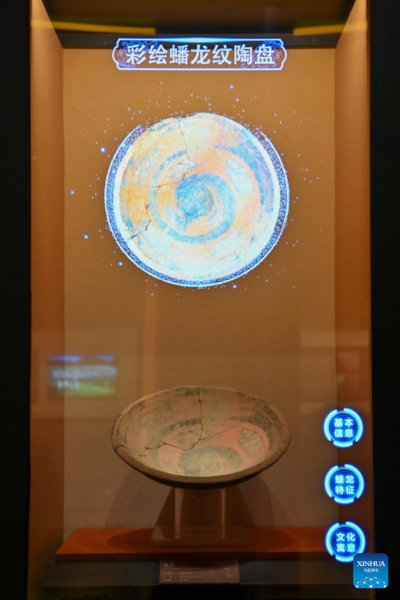 |
|
An exhibit is pictured in the Taosi Site Museum in Xiangfen County, north China's Shanxi Province, Nov. 12, 2024. A museum showing cultural relics dating back 3,900 to 4,300 years opened to the public Tuesday in north China's Shanxi Province, offering a look at early Chinese state formation and societal complexity. [Xinhua/Yang Chenguang] |
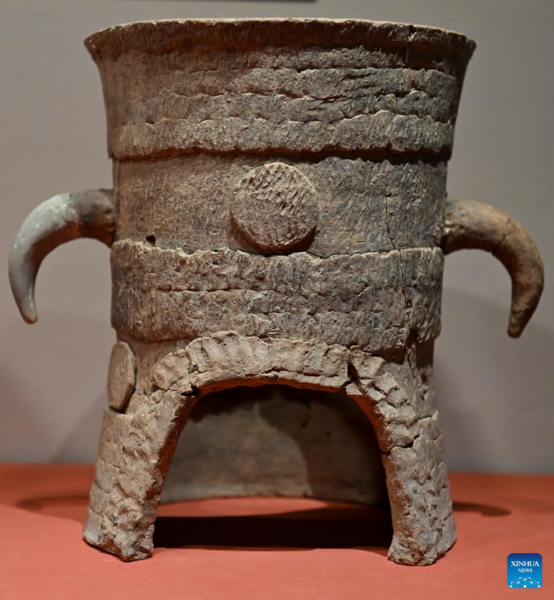 |
|
An exhibit is pictured in the Taosi Site Museum in Xiangfen County, north China's Shanxi Province, Nov. 12, 2024. A museum showing cultural relics dating back 3,900 to 4,300 years opened to the public Tuesday in north China's Shanxi Province, offering a look at early Chinese state formation and societal complexity. [Xinhua/Yang Chenguang] |
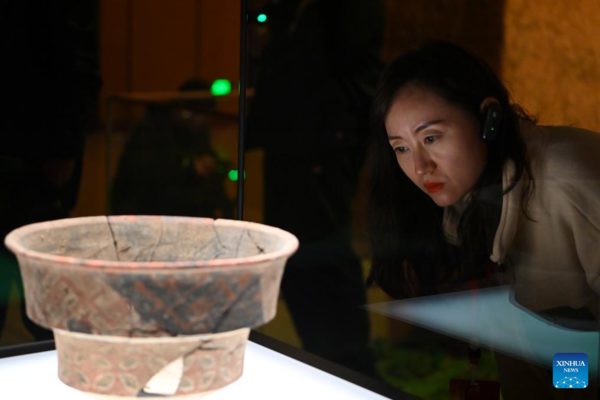 |
|
A visitor looks at an exhibit in the Taosi Site Museum in Xiangfen County, north China's Shanxi Province, Nov. 12, 2024. A museum showing cultural relics dating back 3,900 to 4,300 years opened to the public Tuesday in north China's Shanxi Province, offering a look at early Chinese state formation and societal complexity. [Xinhua/Yang Chenguang] |
 |
|
A performance is staged during the opening ceremony of the Taosi Site Museum in Xiangfen County, north China's Shanxi Province, Nov. 12, 2024. A museum showing cultural relics dating back 3,900 to 4,300 years opened to the public Tuesday in north China's Shanxi Province, offering a look at early Chinese state formation and societal complexity. [Xinhua/Yang Chenguang] |
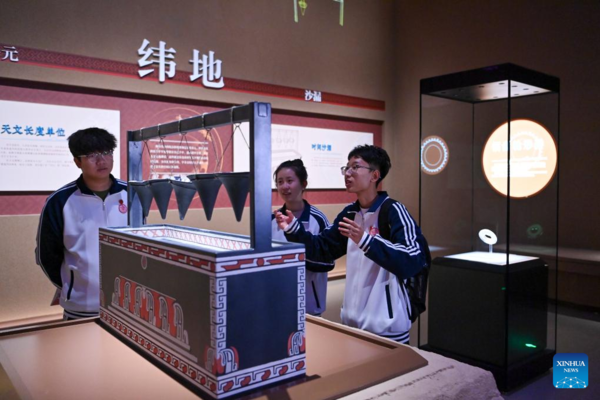 |
|
People visit the Taosi Site Museum in Xiangfen County, north China's Shanxi Province, Nov. 12, 2024. A museum showing cultural relics dating back 3,900 to 4,300 years opened to the public Tuesday in north China's Shanxi Province, offering a look at early Chinese state formation and societal complexity. [Xinhua/Yang Chenguang] |
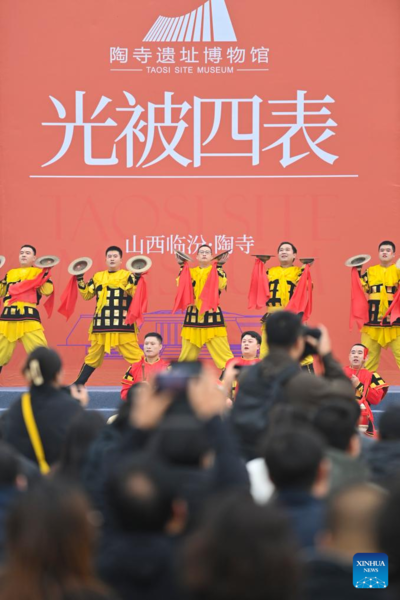 |
|
A performance is staged during the opening ceremony of the Taosi Site Museum in Xiangfen County, north China's Shanxi Province, Nov. 12, 2024. A museum showing cultural relics dating back 3,900 to 4,300 years opened to the public Tuesday in north China's Shanxi Province, offering a look at early Chinese state formation and societal complexity. [Xinhua/Yang Chenguang] |
 |
|
An aerial drone photo shows the Taosi Site Museum in Xiangfen County, north China's Shanxi Province, Nov. 12, 2024. A museum showing cultural relics dating back 3,900 to 4,300 years opened to the public Tuesday in north China's Shanxi Province, offering a look at early Chinese state formation and societal complexity. [Xinhua/Yang Chenguang] |
(Source: Xinhua)
Editor: Wang Shasha
Please understand that womenofchina.cn,a non-profit, information-communication website, cannot reach every writer before using articles and images. For copyright issues, please contact us by emailing: website@womenofchina.cn. The articles published and opinions expressed on this website represent the opinions of writers and are not necessarily shared by womenofchina.cn.








.jpg)

 WeChat
WeChat Weibo
Weibo 京公网安备 11010102004314号
京公网安备 11010102004314号